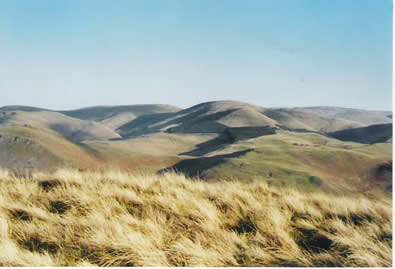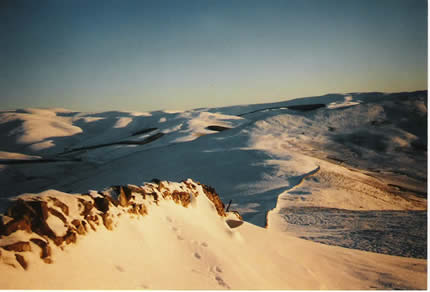Christopher H. Cameron
Kelso, Scottish Borders, United Kingdom

The call came at two o’clock from John, a far-flung hill farmer/patient, who sounded puzzled and alarmed. Two teenage girls had arrived at his door in distress and with a garbled tale. They and a third young girl had been dropped at first light by one set of parents on the Scottish-English border, with the intention of completing the three unsupervised days in the hills required to obtain the Duke of Edinburgh’s Award.1 The young trio, from Devon, had been unpleasantly surprised to encounter the hail, sleet, and rain that had greeted them this May morning in the Scottish Borders. They had bravely waved goodbye to the anxious adults and had set off to climb the well-named Oh Me Edge, the first identifiable hill on the route.
John, the hill sheep-farmer, told us that the girls were nearly incoherent, but had managed to tell him that June, the missing girl, had fallen to the ground in the teeth of the worsening gale, with apparent loss of power and feeling in her lower back and legs. She had been struggling to remove her rucksack just before she fell, and the other girls had seen her twist suddenly as the wind caught her dangling rucksack. They knew a bit about back injuries and the possible danger to the spinal cord. They had managed to pitch their tent, lift her carefully, and lay her flat despite the wind and rain. There they left her while they sought the nearest farm, three miles away. By the time they reached the farm (more by luck than skill) they were seriously distressed. John is a calm man who has dealt with many in trouble in the hills, though never with a story quite like this. His reassuring manner helped calm the girls a little while he phoned me for advice. I sensed the anxiety in his voice; I told him I would come immediately. I knew that it was vital the patient be medically assessed before any more lifting took place (the Mountain Rescue team had also been called). We had a female medical student in the practice at the time, Ruth; and whatever lay ahead, I thought she would find it interesting to accompany me to the hills.
After a quick dash to the house to sweep up boots, coats, and headgear, we drove the sixteen miles up twisting roads to John’s farm. The weather had deteriorated drastically. John indicated the open trailer, which was to be our means of conveyance up the hills. Ruth registered disbelief and poorly concealed dismay, but bravely jumped in. We then endured a journey best forgotten. The day had become by now worthy of winter at its worst. John got us as near to the hill ridges as he could and then accompanied us till we could see the tiny white tent, twisting and turning—but holding fast—in the wind. What would we find? It was strange to think that Ruth and I had been consulting in the comfortable confines of well-equipped medical center an hour or so ago, but were now dependent on whatever basic medical instincts and skills we could bring to bear in this unforgiving environment.
A girl’s white face greeted us. She was lying in exactly the same position in which her friends had placed her before running for help, a cocoon of debatable comfort. Although she had been on her own for at least two hours in a gathering mountain gale, her face betrayed no discernible anxiety. I felt a little ridiculous in clumping boots, with a coat flowing with rain and a medical bag. There was barely room to squeeze into that tiny tent, let alone kneel beside the young girl in order to carry out a medical examination. What this urgent medical history required was a full clinical neurological assessment, especially with an eager medical student in attendance. This, however, was almost impossible in the inhospitable conditions in which we found ourselves. I was able to satisfy myself, however, with the fact that June had no apparent sensation or movement below the waist. Not only did I find this extraordinary, given the traumatic severity of a spinal lesion required to produce this picture, I was also truly amazed at her almost total lack of concern or fear in the face of such terrifying symptoms. Nevertheless, however unlikely the diagnosis, June patently had to be treated as a spinal injury case, at least until neurological investigations could be carried out in a spinal unit. She therefore required very careful lifting and carrying in a special stretcher—certainly not transport in an open trailer.

Mountain Rescue arrived, exhausted and wet—having been successfully called out to find a hill-walker lost in mist and rain. John produced hot tea (typically, he had some flasks stowed in the tractor and had been carrying them secretly up to the tent in a bag under his coat). At this moment, the team successfully transferred June onto the special spinal stretcher and wrapped her with blankets. Almost in tandem with this victorious feat, vivid light spilled across the hills with bewildering speed through the unabating rain, gracing us with a brilliant rainbow arching across the hills. Soon golden sunlight was pouring into the glens, and the long hike began, during which we all took turns carrying June. Ruth was radiant when it was her turn, though doubtless hungry, cold, and probably confused. She was a city girl and had never been in hills like this before; and no student textbook told of tales like this.
Exhausted but exhilarated, we arrived at the farm, welcomed by an ambulance and its crew. Before they left for the spinal unit, I re-examined June in the space and relative comfort of the vehicle. Once again, there was no mistake: June had no apparent feeling or movement in her legs or lower abdomen. And by now she was even more relaxed, indifferent even to symptoms which would frighten other patients. I was increasingly puzzled, but wished her a speedy recovery, and wondered what I would learn about this case from my hospital colleagues.
I phoned the hospital several times in the week that followed. I learnt that June’s symptoms had slowly left her, a little more movement and sensation each day. I learnt that all x-rays, scans and other tests were normal, and that there had thus been no damage to her spinal cord. The staff told me that June had given every sign of contentment in the ward, and that this was even before her symptoms had started to remit. I was also interested to learn that her inappropriate response to potentially serious symptoms, which had so puzzled me, had continued—even before they had begun to remit—and that her parents had later taken home a happy teenager in perfect health. She never talked about the nightmare outing while in the ward, and I had a strong suspicion that she would not be discussing it at home either.
My own view as to what had happened to June that May morning is that she had experienced an intolerable mismatch between expectation and experience. She had to find a way to retreat from such an unimagined and frightening experience to safety—but with her honor intact. It is likely that she would only “know” this at a subconscious level and had probably resorted to the ancient psychological device of hysteria to cope with the trauma.
As medical students we were taught to suspect hysteria when confronted by la belle indifference of the patient to symptoms that would normally cause fear and alarm. Though I had not encountered any cases of florid hysterical conversion (modern patients are becoming too sophisticated to use this ancient stratagem), I remembered that the patient always ensures—at subconscious level—that the sudden onset of her symptoms are witnessed by others.
I was sure that this pattern fit Jane. This poor young girl, who had trained for this great expedition had, no doubt, looked forward with such excitement and packed her bags with such care that she could not face the stark despair of failure on the first day out without a cast-iron justification. This she had achieved. Her companions were either made of sterner stuff, or less obsessed with achievement. I only know that neither Ruth nor I will readily forget what took place that day. We both had learnt of the ferocious power of nature, of the pressures on a young girl engulfed in unimagined hardship, and of her way to resolve an unbearable situation.
Notes
- The Duke of Edinburgh Award, is one of the largest young people’s charities, established in 1956 with the aim of supporting young people ages 14-25, many from disadvantaged backgrounds with financial and other means of volunteering for programs with select objectives, achieving fitness improvements, or acquiring practical skills, and planning/training for three day expeditions in a variety of challenging terrains. Today 275,000 young people take part in these programs, which, in many cases have been life-changing.
CHRISTOPHER H. CAMERON, MB, ChB, was born in 1940 in Edinburgh, Scotland. After schooldays in his home town he commenced studies of classics and ancient history in Edinburgh University in 1957. However, after a year, he underwent a “Damascene conversion,” and moved to the medical school, graduating MB ChB in 1964. After several years of hospital appointments in district hospitals around the UK, including posts in general practice and pediatrics, he became a general practitioner in Kelso, a small country town in the Scottish Borders. He retired from general practice after twenty-five years and recommenced studies as a ‘mature’ student at Edinburgh University, receiving an MA in English Language, Scottish History, Russian and Gaelic, and an MSc in an etymological and linguistic study of non-standard bird-names still in use (mainly among the elderly) in the Scottish Borders.
Highlighted in Frontispiece Fall 2010 – Volume 2, Issue 3

Leave a Reply